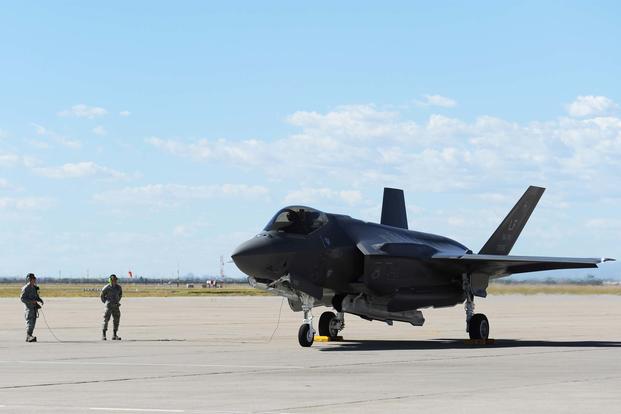The Air Force has grounded all F-35 Joint Strike Fighters at Luke Air Force Base, Arizona, after pilots complained of hypoxia-related issues, officials said Friday.
"The 56th Fighter Wing at Luke Air Force Base, Arizona, canceled local flying operations today for F-35A Lightning II aircraft due to a series of five incidents in which pilots have experienced hypoxia-like symptoms," Air Force spokesman Capt. Mark Graff said in an email.
A total of 48 aircraft and 49 pilots are affected by the temporary stand-down, according to Maj. Rebecca Heyse, a spokeswoman for the base.
"Flying operations are planned to resume Monday, June 12," she said in an email.
The incident is "limited to Luke" at this time, meaning other bases aren't affected by the order, Graff said.
Since May 2, five F-35A pilots have experienced "physiological incidents while flying," according to the statement from Heyse. In each case, the aircraft's backup oxygen system kicked in and the pilot followed the correct procedures to land safely, it stated.
"In order to synchronize operations and maintenance efforts toward safe flying operations, we have canceled local F-35A flying," Brig. Gen. Brook Leonard, 56th Fighter Wing commander, said in the statement. "The Air Force takes these physiological incidents seriously, and our focus is on the safety and well-being of our pilots. We are taking the necessary steps to find the root cause of these incidents."
The Air Force on Friday contacted other F-35 squadrons and international partners operating the aircraft to educate pilots on the incident, according to the statement from Graff.
Graff didn't say whether B or C model variants, flown by the Navy and Marine Corps, have experienced similar problems.
The issue of military pilots suffering hypoxia-like symptoms -- shortness of breath, confusion, wheezing -- isn't limited to the F-35 fleet.
Pilots flying the F-22 Raptor fifth-generation stealth jet experienced hypoxia symptoms on various occasions between 2008 and 2012. One pilot died as a result, and one had a near-death scare, with dozens more pilots experiencing confusion and disorientation while flying, according to an ABC News investigation at the time.
Then-Pentagon spokesman George Little said investigators found the cause to be a faulty valve in the high-pressure vest worn by the pilots at extreme altitude, which was restricting their ability to breathe.
More recently, the Navy went so far as to equip the aircraft carrier USS George H. W. Bush with specialized equipment called a transportable recompression system, or hyperbaric chamber, amid a review of physiological episodes affecting pilots who flew the T-45 trainer and the F/A-18 Hornet.
Graff couldn't say whether the F-35 and T-45 incidents are somehow connected.
The statement he provided said, "Pilots will also be briefed on all the incidents that have occurred and the successful actions taken by the pilots to safely recover their aircraft."
Medical crew will give briefings on physiological event symptoms and "the extensive measures that are being taken to analyze data collected from the incidents," it said. "Finally, the 56th Operations Group will hold an open forum to discuss any concerns pilots may have, given these recent occurrences."
The F-35 Joint Program Office has also stood up a "formal action team" of engineers, maintainers and aeromedical specialists to examine the incidents to better understand the issue, according to the statement.
The incident will not impact the service's plans to send the F-35As to the Paris Air Show this month, Heyse said.
Originally, two F-35As -- one from Luke and another from Hill Air Force Base in Utah -- were set to participate at the show, taking place June 19-25. Graff said plans changed, and two jets from Hill will fly in the show.
Lockheed Martin Corp. pilots are set to fly at the Paris Air Show instead of military pilots, "due to the Air Force's limited number of aircraft, pilots and maintenance professionals," Graff said last month.
Meanwhile, pilots in the service's "B-course" -- six airmen, including first and second lieutenants, who fly the F-35, have not been impacted by the hypoxia-related issue, Heyse said.
"The B-Course pilots were actually in Mountain Home AFB, Idaho, this week for a training trip. They are flying home today in seven jets, which is one day earlier than was planned, but no overall impact on their training," she said.
A total of 55 F-35As are assigned to Luke.
The latest hypoxia incident comes less than a year after the service ordered a temporary stand-down of 13 out of 104 F-35s in the fleet, "due to the discovery of peeling and crumbling insulation in avionics cooling lines inside the fuel tanks," Air Force spokeswoman Ann Stefanek said in September.
The issue, discovered during depot servicing, affected a total of 57 aircraft, Stefanek said. The jets were back up and flying in November.
-- Oriana Pawlyk can be reached at oriana.pawlyk@military.com. Follow her on Twitter at@Oriana0214.
Related Video:































